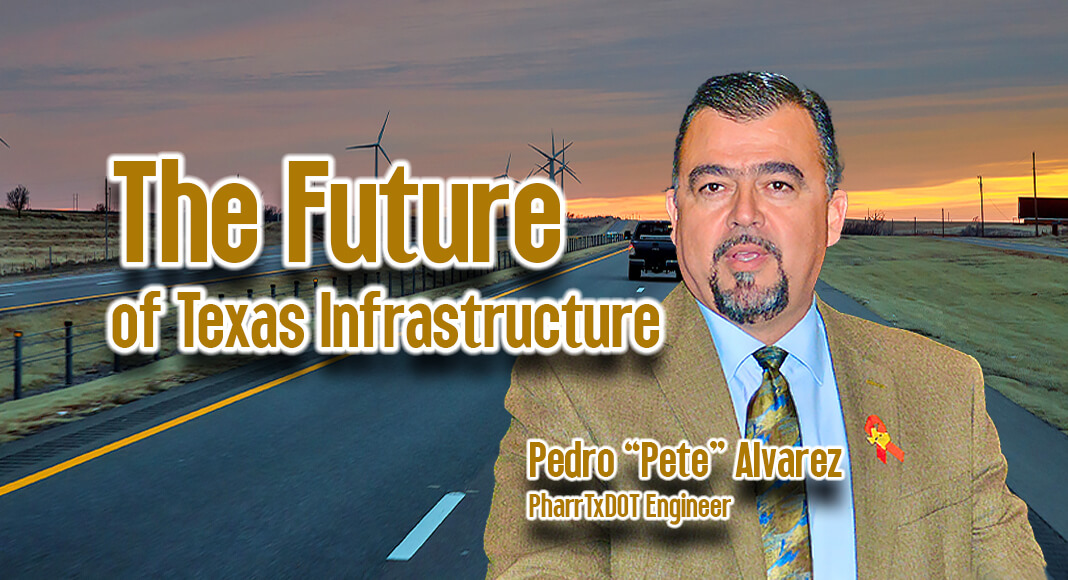
Texas Border Business
By Roberto Hugo González
When you think about Texas’s infrastructure and transportation plans for the next ten years, one can’t help but wonder how emerging technologies, population growth, and economic changes will shape the roadmap. Texas Border Business spoke with Pete Alvarez, the TxDOT Pharr District Engineer, to get answers to these questions.
Diving into the conversation, Texas Border Business asked how electric vehicle charging stations, a prominent emerging technology, factor into the state’s 10-year plan. “We’ve identified opportunities utilizing grant funding that become available to us.” Alvarez began, acknowledging the significance of electric vehicles. “Not only at TxDOT are we looking at this, but the private sector is also investing to ensure we have enough charging stations.”
When questioned about plans regarding the positioning of these charging stations and the state’s involvement, Alvarez had a precise response. “We’ve identified five locations already here in the valley… Ultimately, there’ll be ten stations.” He added that the stations would be strategically placed on the interstate approximately every 50 miles.
Speaking about disparities in infrastructure development, Alvarez emphasized the commission’s commitment to ensuring equal opportunities. “It’s about the movement of people and goods,” he stated. Highlighting the importance of rural connectivity and the need to bridge urban areas. He continued, “Having the rural proportion increase over the years has provided the opportunity to connect the urbanized areas.”
Regarding potential cost overruns or project delays, Alvarez candidly discussed the challenges of budgeting, inflation, and the volatile nature of construction costs. “We’ve been blessed with Prop 1 and Prop 7… but yes, recently, the prices have been coming in a lot higher,” he stated.
He said that regarding collaboration on projects like the International Bridge Trade Corridor, TxDOT actively collaborates with neighboring states, particularly Mexico. A testament to this collaboration is the Border Trade Advisory Committee, comprising members from Texas and Mexico, including states like Tamaulipas that share the border. Alvarez pointed out that regular meetings are held to align on mutual needs and concerns, especially considering the shared responsibilities like warehousing, third-party logistics, and transporting oversized vehicles. These continuous dialogues ensure both nations are in sync regarding cross-border requirements.
Discussing employment opportunities and the state’s projected growth, he said, “The employment opportunities stemming from the 10-year plan are promising, although is challenging to pinpoint precisely.”
Highlighting the financial growth, Alvarez noted that while the UTP was valued at approximately $600 million in 2017, it has surged to a staggering $3.6 billion in 2024, marking an impressive 500% increase. While it might not translate directly to job numbers, according to him, this growth indicates a forthcoming wave of projects and substantial construction activity. He confidently predicted numerous construction projects and opportunities for the region.
When Alvarez was questioned about the Texas economy’s surge and population growth and how these projections align with the UTP, he explained: “The people in Texas are anticipated to see a twofold increase, moving from roughly 1.5 million to 3 million by 2050.”
Addressing how these growth estimations will impact the UTP, Alvarez clarified that there needs to be a more straightforward correlation. “The Unified Transportation Program’s strategy is to prioritize the most urgent projects. TxDOT is responsible for perceiving current and future needs and working collaboratively with local governments to prioritize the initiatives,” he said.
Addressing the equity in transportation enhancements, the commission acknowledges the past tendencies of concentrating funding on urban sectors, given the high traffic volumes there. However, TxDOT is aware of the importance of bridging rural areas to urban hubs. The core focus remains on ensuring the seamless movement of individuals and commodities. To this end, there’s been a conscious effort to enhance rural connectivity over the years, bridging the gap between urbanized regions.
The question touches on a critical aspect of assessing and contrasting the efficacy of finished projects against performance targets: Does TxDOT have mechanisms to gauge the success of finalized projects in terms of meeting objectives such as alleviating traffic or enhancing safety? “Absolutely.” He continued, “This evaluation is ongoing. For instance, examining safety data, we noticed that on routes like FM 2220 or Ware Road, there was a significant reduction in accidents after construction. To illustrate, once there was a high rate of accidents, a subsequent analysis showed a remarkable 66% reduction. This underscores our commitment to routinely check the system’s performance, comparing pre- and post-construction data. We continuously evaluate how the system is performing,” he reiterated.
As for the booming Texas economy and population growth, Alvarez acknowledged the projections. “From a population standpoint, we’re expected to double…” he revealed. However, he emphasized that while population growth projections were significant, the UTP would prioritize the highest necessity projects.
As our discussion drew to a close, it was clear that Texas’ transportation future was being shaped by a blend of emerging technologies, economic considerations, and strategic planning. At the top of this evolution, individuals like Pete Alvarez and a team of talented professionals ensure that the state’s infrastructure is prepared to meet the demands of tomorrow.
See Related Stories:












